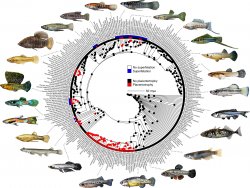Ladies’ choice: What drives faster, flashier formation of new animal species
Dr. Robert Meredith participates in research helping to answer questions revolving around sexual selection and evolutionary biology.
Posted in: Our Research

Evolution is actually a Sadie Hawkins dance, as new research shows females not only determine whether male animals develop bright colors, but also how fast new species develop.
Research led by David Reznick, a UC Riverside biology professor, used fish often seen in pet stores, like guppies and swordtails, to test a hypothesis proposed by David and Jean Zeh at the University of Nevada, Reno. They predicted that the way mothers nurture their young influences the evolution of male traits, and Reznick’s team is the first to find that the prediction was correct.
A paper describing the research was published online today in Nature Communications.
Reznick was inspired to test the hypothesis while wandering the aisles of a pet store. Having spent more than a decade studying fish in the guppy family, he knew the ones in the store had a few things in common.
The fish I saw that day all belong to the Poeciliidae family, which give birth to live young, rather than lay eggs. Some of them even have placentas, like mammals,” Reznick said. “The ones offered for sale were only species with colorful males and all of those species had mothers that lack placentas. I wanted to know how having this type of mother might relate to the evolution of male traits.
Content published by University of California Riverside, written by Jules Bernstein.
